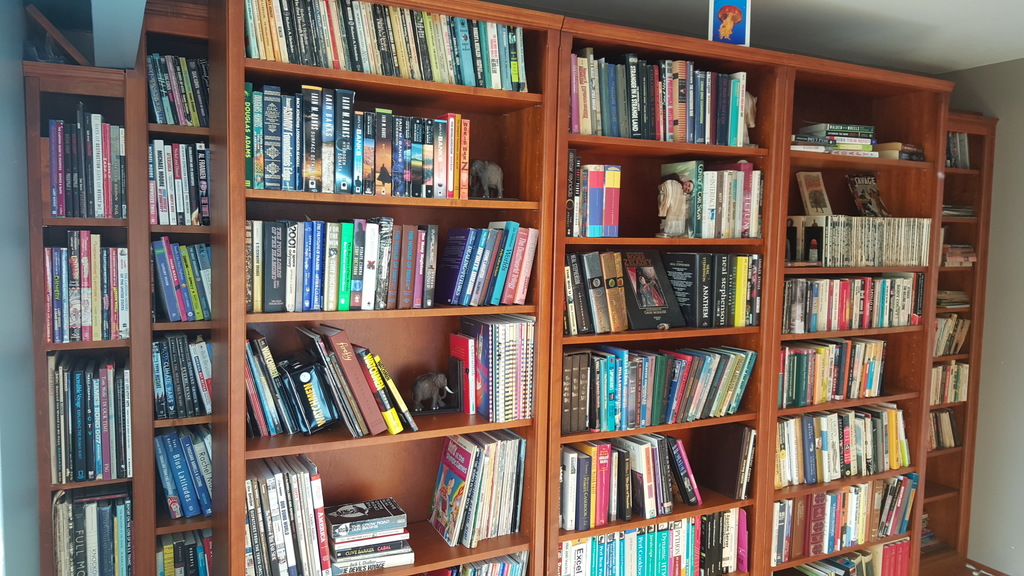
The new shelves take up one entire wall of the spare bedroom. I was assured it is a bearing wall, with another wall under it, though the timbers in this building are so big and solid it probably wouldn't matter.
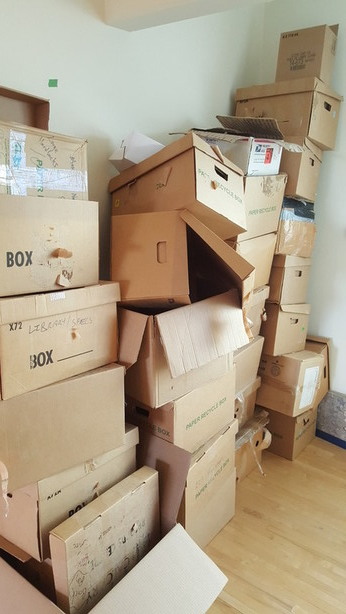 For nearly two years, since I started packing them up in June of 2014, my beloved books have been languishing in cardboard boxes. The survivors, that is. About six or eight boxes were sold off to Fair's Fair used bookstore. But they rejected more than they took, and another dozen boxes were simply tossed. It was a good third of the total, I think, from nearly 50 years of collecting them - I have a few of my childhood books in the library.
For nearly two years, since I started packing them up in June of 2014, my beloved books have been languishing in cardboard boxes. The survivors, that is. About six or eight boxes were sold off to Fair's Fair used bookstore. But they rejected more than they took, and another dozen boxes were simply tossed. It was a good third of the total, I think, from nearly 50 years of collecting them - I have a few of my childhood books in the library.
Well, here the boxes are, gathered from all the places they had to be stashed around the house; the piles out in the patio, the ones beside my bed, the ones along the walls. It's like losing a bunch of our furniture, as there was stuff sitting on the piles of boxes and now we have to find places to put it all.
Since they were spread all around, it was amazing just how big a pile of boxes of books it really was when they were all gathered together here, empty, after three straight days of sorting their contents into shelves.
There was some back pain, of course: hauling these things around and pulling out at least a ton of books from them took its toll.
But, oh, boy is it worth it.
I had a fairly good book solution back in Calgary; there was a whole bedroom lined with various shelves from Ikea and other affordable furniture sources, plus smaller stand-alone shelves in the hallway and other rooms.
But here, I have the Ultimate Book Solution.

The new shelves take up one entire wall of the spare bedroom. I was assured it is a bearing wall, with another wall under it, though the timbers in this building are so big and solid it probably wouldn't matter.
Where I say "takes up one wall", I mean to the millimetre. This is custom furniture that was measured in - there's an odd little 8-inch wide bookcase at far left in this picture, where a built-in curtain valence makes the ceiling a different height; to the right of it, you can see both "layers" of the taller bookcase that goes the remaining four metres across the room - the fixed back layer, and the three sliding cases of the front layer.
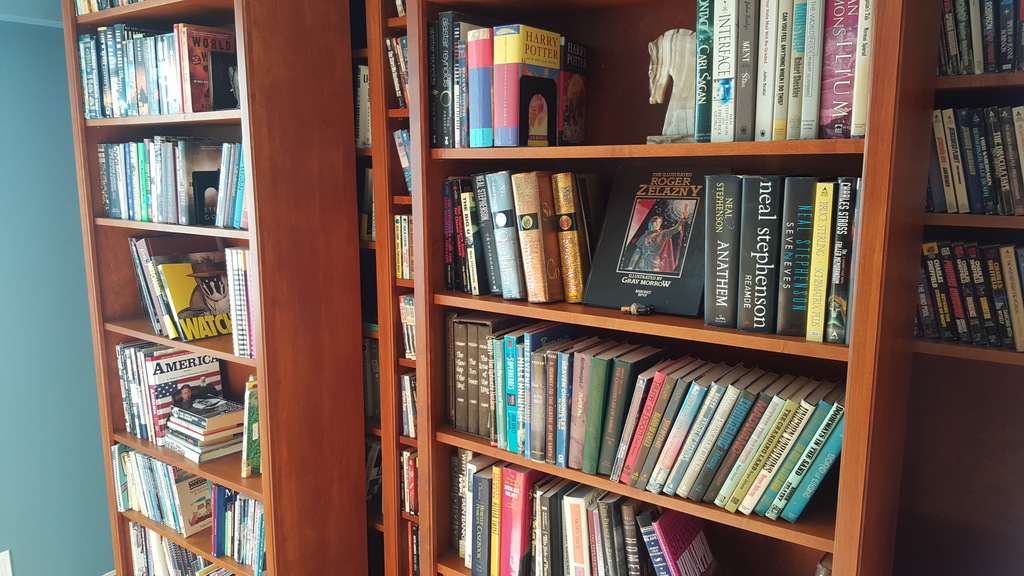
With 100kg or more in each case, they don't roll along at a touch, you have to put the palm of your hand on the middle of the side and give it a solid push. But a child could roll them back and forth.
A child might have to really lean in when pushing all three cases together, however; I have to lean over at several degrees and put some back into it.
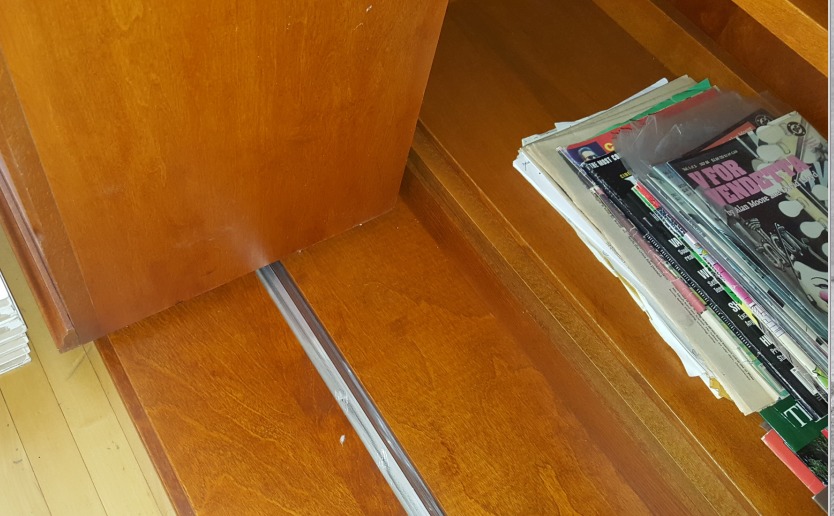 Surprisingly, they run at the bottom on just one metal track, into which two brass wheels on each case run, slightly concave to keep them on the track. The cases balance:
Surprisingly, they run at the bottom on just one metal track, into which two brass wheels on each case run, slightly concave to keep them on the track. The cases balance:
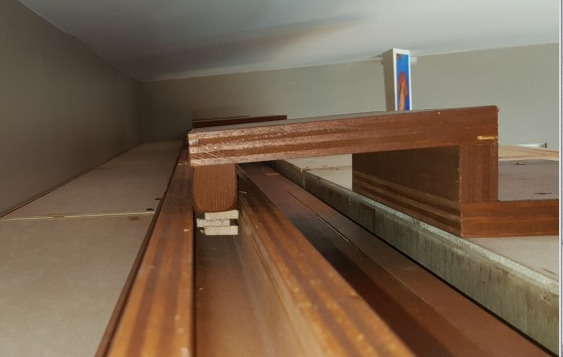 ...by also running an arm over onto the top of the back cases, into a track up there. That's so much more stabilizing than a second track on the bottom could be that having it would be pointless.
...by also running an arm over onto the top of the back cases, into a track up there. That's so much more stabilizing than a second track on the bottom could be that having it would be pointless.
All told, it's seven bays, of nearly a metre width each, of 2.2 metre tall shelving, and I changed my philosophy on this library, for greater storage. My old library had imitated professional ones, with organization by topic; all the politics books were together, all the astronomy.
This one does that where it can - SF paperbacks separate from other fiction - but mostly it sorts by SIZE. All the super tall books are together in that very narrow case under the valence.
But no paperbacks are stored where the shelves are taller than they need; no volume is wasted where avoidable.
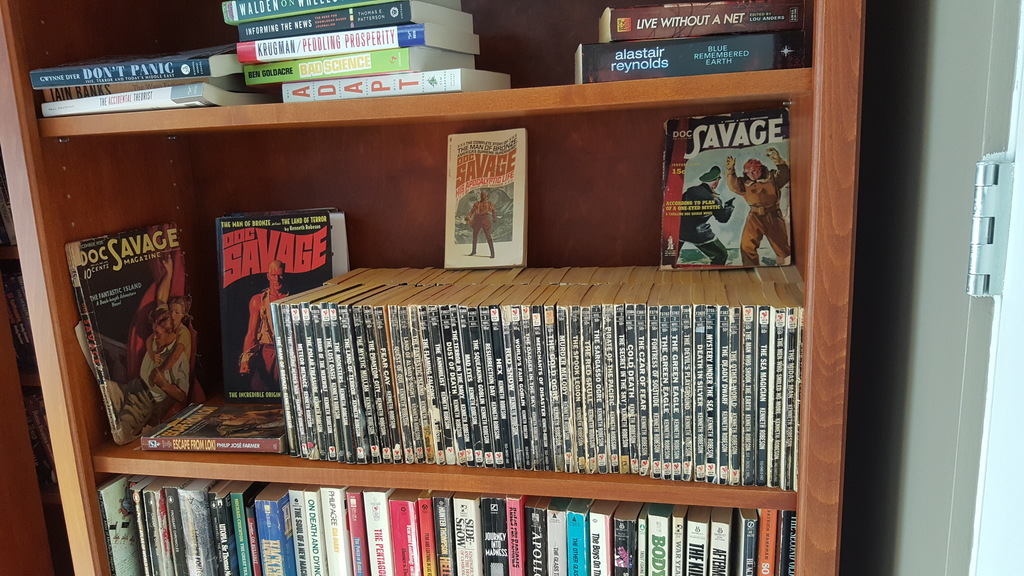
At the moment, the bulk of spare space has been devoted to a little 'shrine' to "Doc Savage" perhaps the first pulp-fiction superhero. Invented as monthly pulp stories for teen boys in 1931, Doc did follow "The Shadow" (who had the power to 'cloud men's minds' and disappear into the shadows, invisible) but pre-dated all the other superheros still out there today. Doc had no magic, beyond-physics powers, though; that was what attracted, he was a self-made hero, more like Batman. He had this intense, two-hour daily workout, and invented scores of amazing gadgets. Even his workout was scientifically designed, so like Tony Stark, he was the superhero created by Science. Indeed, some of the early stories were entitled, "Doc Savage, Scientific Detective".
(The "CSI" stories go a long, long way back; Dick Tracy stories had forensic plots in the 1920's, and of course, Sherlock Holmes could recognize 117 types of tobacco ash because of intensive study. Since the 19th century, there's been a love of Science Versus Crime, Science as a servant of morality. It's a welcome contradiction to the WW2 and Atomic Age concerns that Science is more often the servant of evil.)
Doc had a "Fortress of Solitude" in the Arctic where he went away to invent and study; the creator of Superman shamelessly ripped it off a few years later. He had a "utility vest" full of scientific gadgets and gasses he used to outwit bad guys and escape their traps; Batman's "utility belt" full of gadgets was another outright theft.
I learned later, while reading some Doc for a young friend during the pandemic, that the "thefts" were actually a purchase: editors from DC Comics paid off Conde' Nast for rights to just read through Doc stories and take any plots, characters, and ideas in general, that they wanted. So, Batman and Superman are like children-of-Doc, or at least partly inspired by.
It's hard not to assume that James Bond and his many gadgets owe a tip of the hat to the Doc stories, as well; Ian Fleming would have been twenty-three when they started coming out, continued through his war service.
"The Shadow" was a bit of an anti-hero; spooky and unapproachable, he bumped a lot of bad guys off with his twin .45's, and they wanted somebody a little more nice and all-American. Doc was your first true world-ranging superhero, who fought various super-villains all around the world, via his fleet of planes, submarine, fast cars. At the time, it wasn't just adventure fiction, but science fiction; in 1931, zepplins, and aircraft with closed cockpits, and submarines, were like SpaceX craft today; they existed, but barely - most people had never seen one. And Doc had a private zepplin.
Lost Cities and still-running hidden civilizations were a repeated setting for Doc stories, so the Indiana Jones adventures, of the same crucial decade or so, surely owe some nods to Doc, as well. ("Crucial decades", in that after long-distance air travel became possible, but had only been so for a decade or so, was the period when you could with a straight face claim to have voyaged to a Lost City that nobody else had ever found.)
The pulp magazine died in the 1940's, but the stories were resurrected as a line of paperbacks in the 1960's, and I started reading them at ten. When my brother's paperback collection was tossed by our mother, I replaced the Docs from used bookstores and collected them for decades; I believe the collection is now complete - the only thing I ever seriously collected.
It's a true collector's mania - I've never read a third of them; I outgrew the teen stories, after all. But I now have a couple of those almost-unobtainable original pulp magazines from the early 30's on display. In the old house, I was so out of space that the Docs were in the basement, the collector's-item 1930's mags in plastic bags in boxes.
Now that they're all out on prominent display in my face, maybe I'll finally read them all!

 You see, it was autographed by Zelazny, and illustrator Gray Morrow. It's not super-valuable; I've looked it up on ebay, and 2500 copies seems enough to keep it from exploding in value, but for me, it's a treasure I wouldn't part with.
You see, it was autographed by Zelazny, and illustrator Gray Morrow. It's not super-valuable; I've looked it up on ebay, and 2500 copies seems enough to keep it from exploding in value, but for me, it's a treasure I wouldn't part with.
Besides a bunch of his best short stories turned into excellent graphic novel formats, it has the "Amber Tapestry" four-page spread of collage:

And above all, it has a "Jack of Shadows" short story of one of his best heists before the events of the novel. I'm not aware of it being available in any other collection.

